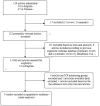The effects of intracranial pressure monitoring in patients with traumatic brain injury
- PMID: 24586276
- PMCID: PMC3931613
- DOI: 10.1371/journal.pone.0087432
The effects of intracranial pressure monitoring in patients with traumatic brain injury
Abstract
Background: Although international guideline recommended routine intracranial pressure (ICP) monitoring for patients with severe traumatic brain injury(TBI), there were conflicting outcomes attributable to ICP monitoring according to the published studies. Hence, we conducted a meta-analysis to evaluate the efficacy and safety of ICP monitoring in patients with TBI.
Methods: Based on previous reviews, PubMed and two Chinese databases (Wangfang and VIP) were further searched to identify eligible studies. The primary outcome was mortality. Secondary outcomes included unfavourable outcome, adverse events, length of ICU stay and length of hospital stay. Weighted mean difference (WMD), odds ratio (OR) and 95% confidence intervals (CIs) were calculated and pooled using fixed-effects or random-effects model.
Results: two randomized controlled trials (RCTs) and seven cohort studies involving 11,038 patients met the inclusion criteria. ICP monitoring was not associated with a significant reduction in mortality (OR, 1.16; 95% CI, 0.87-1.54), with substantial heterogeneity (I(2) = 80%, P<0.00001), which was verified by the sensitivity analyses. No significant difference was found in the occurrence of unfavourable outcome (OR, 1.40; 95% CI, 0.99-1.98; I(2) = 4%, P = 0.35) and adverse events (OR, 1.04; 95% CI, 0.64-1.70; I(2) = 78%, P = 0.03). However, we should be cautious to the result of adverse events because of the substantial heterogeneity in the comparison. Furthermore, longer ICU and hospital stay were the consistent tendency according to the pooled studies.
Conclusions: No benefit was found in patients with TBI who underwent ICP monitoring. Considering substantial clinical heterogeneity, further large sample size RCTs are needed to confirm the current findings.
Conflict of interest statement
Figures




Similar articles
-
Predictors of intensive care unit length of stay and intracranial pressure in severe traumatic brain injury.J Crit Care. 2015 Dec;30(6):1258-62. doi: 10.1016/j.jcrc.2015.08.003. Epub 2015 Aug 5. J Crit Care. 2015. PMID: 26324412 Free PMC article.
-
Effects of Intracranial Pressure Monitoring on Mortality in Patients with Severe Traumatic Brain Injury: A Meta-Analysis.PLoS One. 2016 Dec 28;11(12):e0168901. doi: 10.1371/journal.pone.0168901. eCollection 2016. PLoS One. 2016. PMID: 28030638 Free PMC article.
-
Functional Outcome After Intracranial Pressure Monitoring for Children With Severe Traumatic Brain Injury.JAMA Pediatr. 2017 Oct 1;171(10):965-971. doi: 10.1001/jamapediatrics.2017.2127. JAMA Pediatr. 2017. PMID: 28846763 Free PMC article.
-
Brain tissue oxygen pressure combined with intracranial pressure monitoring may improve clinical outcomes for patients with severe traumatic brain injury: a systemic review and meta-analysis.PeerJ. 2024 Oct 8;12:e18086. doi: 10.7717/peerj.18086. eCollection 2024. PeerJ. 2024. PMID: 39399425 Free PMC article.
-
Brain tissue oxygen partial pressure monitoring and prognosis of patients with traumatic brain injury: a meta-analysis.Neurosurg Rev. 2024 May 17;47(1):222. doi: 10.1007/s10143-024-02439-4. Neurosurg Rev. 2024. PMID: 38758384 Free PMC article. Review.
Cited by
-
Predictors of intensive care unit length of stay and intracranial pressure in severe traumatic brain injury.J Crit Care. 2015 Dec;30(6):1258-62. doi: 10.1016/j.jcrc.2015.08.003. Epub 2015 Aug 5. J Crit Care. 2015. PMID: 26324412 Free PMC article.
-
Comparative Effectiveness of Intracranial Pressure Monitoring vs No Monitoring in Severe Penetrating Brain Injury Management.JAMA Netw Open. 2023 Mar 1;6(3):e231077. doi: 10.1001/jamanetworkopen.2023.1077. JAMA Netw Open. 2023. PMID: 36961466 Free PMC article.
-
Intracranial pressure monitoring in diffuse brain injury-why the developing world needs it more?Acta Neurochir (Wien). 2018 Jun;160(6):1291-1299. doi: 10.1007/s00701-018-3538-4. Epub 2018 Apr 26. Acta Neurochir (Wien). 2018. PMID: 29696505
-
Effects of intracranial pressure monitoring in pediatric severe traumatic brain injury: a meta-analysis of cohort studies.Front Neurol. 2025 Mar 17;16:1557820. doi: 10.3389/fneur.2025.1557820. eCollection 2025. Front Neurol. 2025. PMID: 40166641 Free PMC article.
-
Effects of Intracranial Pressure Monitoring on Mortality in Patients with Severe Traumatic Brain Injury: A Meta-Analysis.PLoS One. 2016 Dec 28;11(12):e0168901. doi: 10.1371/journal.pone.0168901. eCollection 2016. PLoS One. 2016. PMID: 28030638 Free PMC article.
References
-
- Langlois JA, Rutland-Brown W, Wald MM (2006) The epidemiology and impact of traumatic brain injury: a brief overview. J Head Trauma Rehabil 21: 375–378. - PubMed
-
- Padayachy LC, Figaji AA, Bullock MR (2010) Intracranial pressure monitoring for traumatic brain injury in the modern era. Childs Nerv Syst 26: 441–452. - PubMed
-
- Miller JD, Becker DP, Ward JD, Sullivan HG, Adams WE, et al. (1977) Significance of intracranial hypertension in severe head injury. J Neurosurg 47: 503–516. - PubMed
-
- Enblad P, Nilsson P, Chambers I, Citerio G, Fiddes H, et al. (2004) R3-survey of traumatic brain injury management in European Brain IT centres year 2001. Intensive Care Med 30: 1058–1065. - PubMed
-
- Brain Trauma Foundation, American Association of Neurological Surgeons, Congress of Neurological Surgeons, Joint Section on Neurotrauma and Critical Care, AANS/CNS, et al (2007) Guidelines for the management of severe traumatic brain injury. VI. Indications for intracranial pressure monitoring. J Neurotrauma 24 Suppl 1 S37–S44. - PubMed
Publication types
MeSH terms
LinkOut - more resources
Full Text Sources
Other Literature Sources
Miscellaneous

